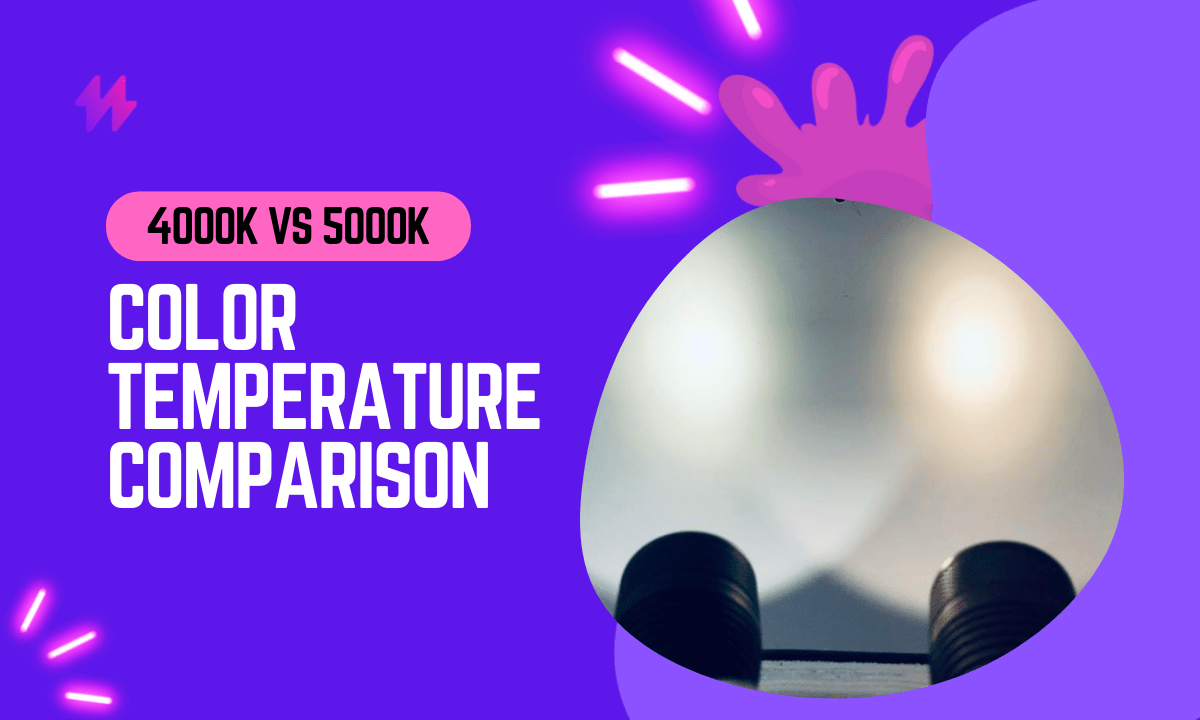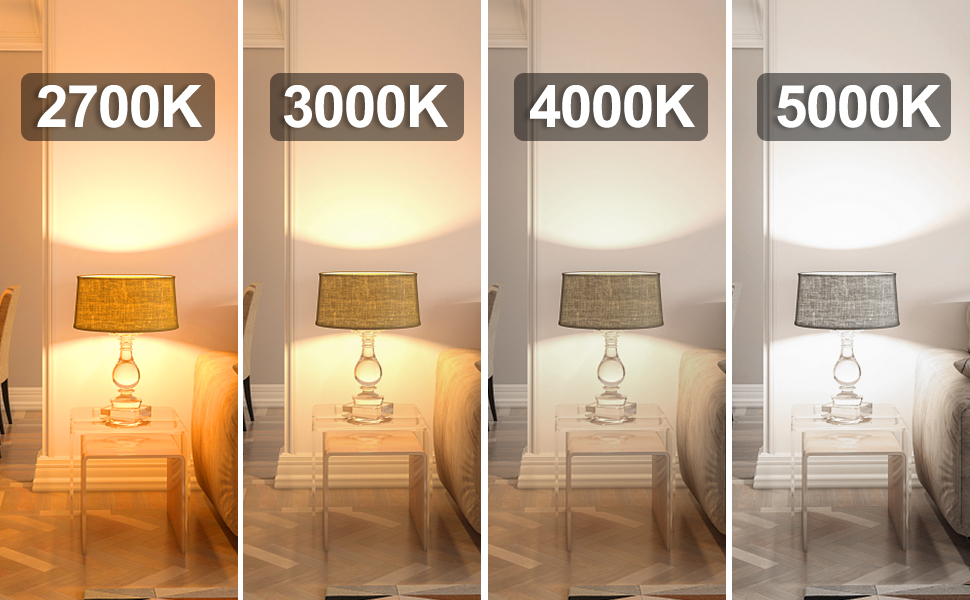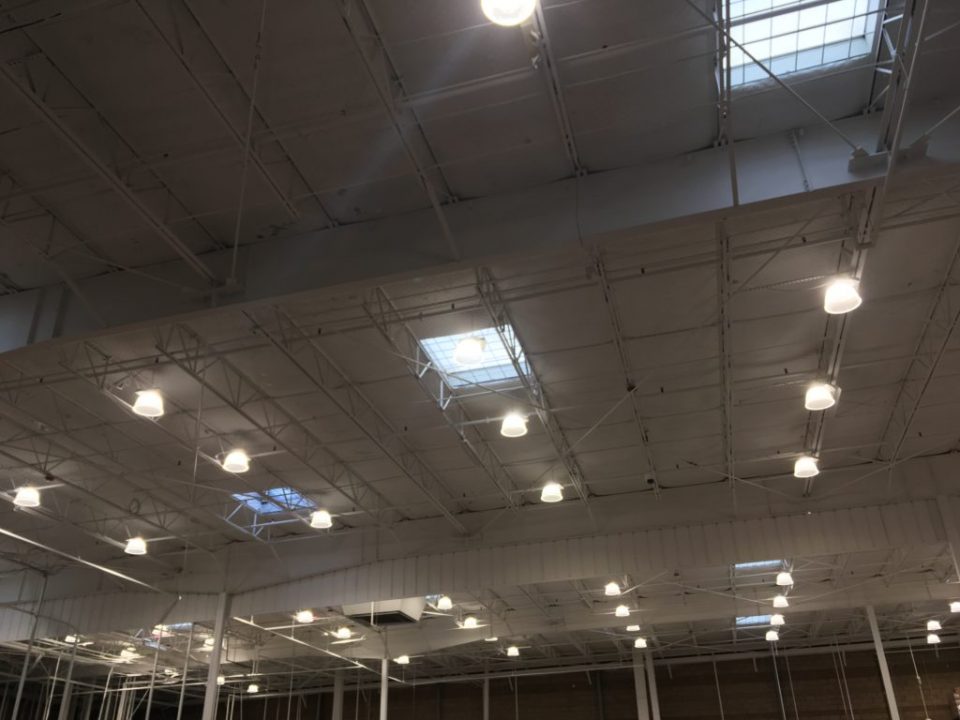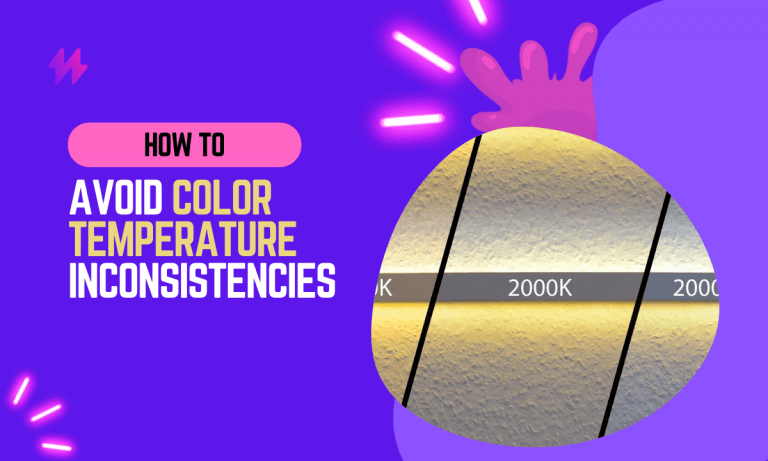4000K vs 5000K LED Color Temperature Comparison

LED color temperature is a measure of the spectral power distribution of an LED light. The higher the color temperature, the whiter and cooler the light appears to be. LED lights with a lower color temperature to appear more yellow or orange. Color temperatures are measured in Kelvin (K).
The most common LED colors are 2700K, 3000k, 4000K, and 5000K. 4000K LEDs produce a warm white light while 5000K LEDs produce a cool white light. Some people prefer 4000K LEDs because they provide a more natural look, while others prefer 5000K LEDs because they provide more illumination.

Understanding the Kelvin color temperature scale is essential for selecting the appropriate LED bulbs for different lighting needs. For instance, 5000K generates a chilly white light with a blue tint that is perfect for high visibility areas, while 4000K offers a warmer color temperature that’s suitable for family areas and warm weather.
4000k vs 5000k LED Color Temperature Comparison: Understanding the Differences
A 4000k LED light has a color temperature of 4000 Kelvin. This is a very popular color temperature for LEDs because it produces a warm white light that is similar to the light produced by incandescent bulbs.
4000K LEDs are often used in living rooms and bedrooms because they create a cozy and inviting atmosphere.
For those seeking to enhance their lighting options, understanding the different color temperatures is paramount. When choosing a light bulb or LED strip light, 4000K provides a warmer color temperature that is not only suitable for cool weather but also fosters a cozy ambiance in family areas.
Optimal Applications for 4000k LED Lights | Usage Guidelines
- 4000k lights are perfect for living rooms and bedrooms because they produce a warm and inviting atmosphere.
- 4000k lights can also be used in places like offices, Garages, and Retail Spaces.
- 4000k lights can be used in any room of the house, but they are best suited for areas where you want to create a relaxed and comfortable environment.
Also read: Soft White vs Daylight which is better?
When selecting LED bulbs, it’s important to consider the right color temperature, as each temperature rating influences the atmosphere of a room. The Kelvin scale helps determine whether to opt for warmer light or cooler colors, allowing for an accurate color perception that enhances the overall lighting experience.
Exploring 5000k LED Color Temperature: A Comprehensive Guide

A 5000k LED light has a color temperature of 5000 Kelvin. This is a very popular color temperature for LEDs because it produces a cool white light that is similar to the light produced by fluorescent bulbs.
5000K LEDs are often used in kitchens and bathrooms because they provide more illumination than 4000K LEDs.
When selecting LED bulbs, understanding the Kelvin temperature scale is crucial, as it informs users about the color spectrum emitted by the light source. A proper color temperature rating helps ensure that the lighting solution fits the intended atmosphere, whether for creating a warm ambiance in family areas or opting for cooler color temperatures in more functional spaces.
Optimal Applications for 5000k LED Lights: Where to Use Them?
- 5000k lights are perfect for kitchens and bathrooms because they provide more illumination than 4000K LEDs.
- 5000k lights can also be used in Showrooms, Art Galleries, stadiums, Hospitals, Studios, and warehouses.
- 5000k lights can be used in any room of the house, but they are best suited for areas where you want to create a bright and airy environment.
4000k vs 5000k LED Color Temperature Comparison: Which is Better?
The answer to this question depends on your personal preferences. The main difference between 4000k and 5000k LED color temperatures is the level of illumination they provide. 4000k LEDs produce a warmer, more inviting light while 5000k LEDs produce a cooler, more bright light.
4000k LEDs are often used in living rooms and bedrooms because they create a cozy and inviting atmosphere, while 5000k LEDs are often used in kitchens and bathrooms because they provide more illumination.
Overall, the 4000k vs 5000k LED color temperature comparison comes down to personal preference. If you prefer a warmer, more natural light, then 4000k LEDs are the better choice. If you prefer a brighter, more fluorescent-like light, then 5000k LEDs are the better choice.
Choosing the right LEDs can dramatically alter the ambiance of your space depending on the “correlated color temperature” of the bulbs. For example, while “5000K is colder than 4000K” and mimics “daylight-like color,” “4000K: warmer” is ideal for creating a soothing environment in family areas.
Final Thoughts: 4000k vs 5000k LED Color Temperature
In conclusion, the decision between 4000K and 5000K LED color temperatures hinges on the specific needs and desired atmosphere of the space being illuminated. A 4000K LED provides a neutral, crisp white that tends to soften the environment without straying too far into the warmth of lower color temperatures. This balance makes it exceptionally suitable for areas where both relaxation and concentration are needed, such as living rooms, offices, and kitchens. Its natural white light enhances visual comfort, making it easier on the eyes during tasks that require attention to detail, while still maintaining a welcoming atmosphere for casual social interactions.
Conversely, 5000K LEDs emit a brighter, more vibrant white light that resembles daylight. This color temperature is particularly effective in environments where precise visual tasks are performed, such as garages, basements, or any workspace requiring acute visual accuracy. The cooler, more invigorating quality of 5000K light makes it ideal for settings that benefit from a high level of brightness and clarity. However, due to its intensity, it may not be the best choice for residential living spaces where a warmer, more relaxing light is typically preferred. When choosing between these two color temperatures, it’s important to consider both the functional needs and the emotional tone of the room. Adjustability options, such as dimmers or multi-setting fixtures, can also provide flexibility, allowing occupants to tailor lighting based on the time of day or the task at hand, effectively blending the benefits of both temperature ranges.
4000K Vs 5000K LED Color Temperature Comparison | Characteristics of 4000K LED Lights
The 4000K LED lights present a balanced lighting option, often described as warmer compared to the stark brightness of 5000K LEDs, which produce a colder color temperature. This temperature setting results in a yellowish hue that is not only popular for home environments but also well-suited for cool weather locations, enhancing the ambiance of family areas with a warm effect. Light color temperature plays a crucial role in achieving the right lighting for various applications, influencing color rendering and the overall perception of true colors. Colorimeters and photometers can help measure the color difference and accuracy of these lighting fixtures, ensuring a proper transition color temperature for specific lighting projects. While 4000K offers a more neutral hue, its color temperature range allows it to excel in providing a bright daylight kind of look without causing glare, making it ideal for both residential settings and public lighting applications. Properly designed dimmable LEDs at this kelvin temperature can provide warm ambient light that feels inviting, with significant implications for mood and productivity in various environments.
4000K vs 5000K LED Color Temperature Comparison | Color Rendering Quality of 4000K LEDs
The 4000K LED lights emit a warmer, yellowish light that falls within the neutral color temperature range. This specific color temperature is often preferred for family areas and spaces meant for relaxation, as it creates a welcoming atmosphere. With a color temperature spectrum that balances cool and warm hues, 4000K lights provide high color accuracy and enhanced color contrast, making them suitable for various applications, from home lighting to office environments. Understanding temperatures in the context of visual quality, these lights maintain a bright color without overwhelming brightness or glare, ensuring a comfortable viewing experience.
Conversely, the 5000K LED lights are associated with a colder hue, often resembling daylight colors. These lights deliver an ultra-bright cool light that is ideal for situations requiring high visibility, such as street lighting and workspaces. While both 4000K and 5000K can be used effectively in modern lighting setups, the 4000K options tend to generate a more inviting, warm light color, which may not always be the perfect light source for every scenario. The choice between these popular color temperatures boils down to the desired ambiance and functionality, particularly when considering the lighting intensity and the impact of color temperature values in different environments.
Energy Efficiency of 4000K LED Lights
The energy efficiency of 4000K LED lights is notable, especially when compared to traditional fluorescent lighting. This temperature of light provides a warmer, yellowish light, making it suitable for family areas and cool weather. With a typical range of 3000 to 4000K, these bulbs deliver a brighter look while consuming less wattage than conventional incandescent bulbs. The lumens per watt ratio often exceeds that of traditional lighting, allowing for sufficient illumination without excessive energy consumption. In environments where maintaining an inviting atmosphere is desired, such as living rooms or kitchens, 4000K lights offer the perfect balance of color and efficiency.
Energy efficiency also comes into play with the specific light quality these LEDs provide. In the 4000K vs 5000K LED color temperature comparison, 4000K stands out as it avoids the blueish hue often associated with colder color temperatures. Instead, the warmer color temperatures mimic natural daylight without the harsh glare common in higher Kelvin values. This feature can help create a comfortable space, promoting relaxation and better focus. By utilizing warm yellow light, 4000K LEDs can enhance the overall ambiance while providing adequate brightness for tasks, demonstrating their versatility in various settings.
Characteristics of 5000K LED Lights
The 5000K LED lights deliver a crisp, bright white light that closely resembles natural daylight, making them ideal for environments requiring clarity and focus. In the 4000K vs 5000K LED color temperature comparison, 5000K stands out with its cooler, bluish hue, which can enhance visibility in workspaces or retail areas. While 4000K provides a warmer, yellowish light suitable for family areas and cooler climates, 5000K’s brighter output can create a stark atmosphere that some may find harsh. The kelvin temperatures associated with 5000K add to its appeal in warmer weather locations by mimicking the intensity of a warm midday sun, perfect for achieving full brightness without color distortion. This lighting technique eliminates the dull warm glow of lower kelvins, ensuring that colors appear vibrant and true, though it can sometimes introduce glare and a sense of coolness to a space. Choosing the right lights involves understanding the balance between lumens measure brightness and the desired emotional impact, particularly with regard to color rendering and the overall ambiance created by led strip lights or bulbs like the LED A19.
Color Rendering Quality of 5000K LEDs
The color rendering quality of 5000K LEDs stands out in environments requiring a crisp and clear light. These lights emit a bright white color that closely mimics daylight, making them ideal for workshops and areas where accuracy in color representation is crucial. In 4000K vs 5000K LED color temperature comparisons, the 5000K range emphasizes enhanced visibility thanks to its cooler blue wavelengths. However, this means that while 5000K LEDs offer a clean and energetic feel, they might not be suitable for spaces intended for relaxation or intimate gatherings, where a warmer light color is often preferred.
People often find that 5000K LED lighting can create a stark contrast in spaces decorated with warm color temperature elements, such as warm incandescent bulbs or warm candlelight. The potential for light glare and the intense heat generated by these cooler temperatures can impact the ambiance negatively. Spaces designed for comfort might benefit from the softer qualities of 4000K lights, which provide a gentler glow suitable for family areas. Determining the best choice involves weighing the functional benefits of bright white light against the desire for a warm and inviting atmosphere, particularly in warm weather locations.
Energy Efficiency of 5000K LED Lights
5000K LED lights typically offer higher energy efficiency compared to their 4000K counterparts. The 5000K color temperature emits a crisp, bright white light, making it ideal for spaces that require heightened visibility. This cooler, bluish hue can help reduce the need for additional lighting in larger areas. Whereas 4000K lights emit warmer, yellowish tones that create a cozy atmosphere, they may not be as effective for workspaces or environments demanding focus. The distinction in color temperatures reflects on their application outcomes, especially when considering anti-glare lights to avoid discomfort caused by harsh brightness.
Choosing the right kelvin (K) rating is crucial for optimizing energy consumption. The 5000K LED lights often draw less power while delivering appropriate brightness for settings like offices, garages, and workshops. Their performance can lead to significant savings on energy bills while providing a white color impact that enhances productivity. By contrast, 4000K lights are more suitable for cooler weather and family areas, promoting a warm range of light that feels inviting. Understanding the 4000K vs 5000K LED Color Temperature Comparison helps in selecting the appropriate bulbs for specific needs, ensuring that users enjoy both functional and aesthetic benefits.
Visual Impact of 4000K vs 5000K LED Lighting
The visual impact of 4000K vs 5000K LED color temperature comparison reveals distinct differences that influence room temperature and ambiance. The 4000K lights emit a warmer, yellowish light, creating a cozy atmosphere suitable for cool weather and family areas. In contrast, 5000K lights produce a cooler, bluish hue that mimics natural daylight, often dominating spaces with intense white light color. Choosing the wrong color temperature can drastically alter the perception of a space; whereas similar color temperatures of 4000K and 5000K may appear comparable in kelvins (k), their effect on mood and productivity diverges significantly. Warmer temperatures like 4000K are ideal for setting a relaxing environment, while the darker blue light of 5000K can create a more energizing vibe. Ultimately, the choice of LED lighting, whether it’s an LED A19 bulb or LED strip lighting, impacts not only aesthetics but also the psychological response to a room.
Brightness Perception in 4000K vs 5000K
The 4000K vs 5000K LED Color Temperature Comparison reveals significant differences in brightness perception influenced by the color temperatures. A 4000K LED emits a warmer, yellowish light that creates a cozy ambiance, making it suitable for cool weather and family areas. This color point leans towards a golden hue, enhancing comfort and relaxation. In contrast, 5000K LED lights radiate a stark, bluish light reminiscent of daylight, which can accentuate brightness in spaces but may also create a harsh atmosphere if overused. The cooler color temperature may seem brighter to the eye, but it can also induce feelings of starkness in domestic settings.
Brightness perception is closely linked to the characteristics of the specific light emitted by different LED color temperatures. Reflectors can enhance the effectiveness of both 4000K and 5000K LED strips, but their color profiles can significantly affect the overall lighting experience. While 4000K provides a softer glow, ideal for social interactions, 5000K tends to provide a more alert environment. The interplay between warmer colors and cooler, darker blue light can influence how we perceive brightness in our surroundings. Choosing between these temperatures ultimately depends on the desired mood and functionality of the space being illuminated.
Aesthetic Appeal of Different Color Temperatures
The 4000K vs 5000K LED color temperature comparison reveals distinct aesthetic qualities that influence interior design choices. The 4000K lighting emits a warmer, yellowish light, creating an inviting atmosphere ideal for family areas and cool weather settings. This temperature tends to enhance the golden hues in spaces, making them feel more comfortable and cozy. In contrast, the 5000K blue color lights provide a brighter and more clinical feel, appropriate for workspaces or areas requiring high visibility. The color rendering of these lights can impact how colors appear in a room, with 4000K favoring warmer tones and 5000K highlighting cooler shades.
Selecting the right color temperature can significantly affect the ambiance of a room. For instance, the 4000K LED strip color can evoke a sense of warmth, while the starkness of the 5000K lights might feel overly bright or even create a darkish blue light effect. Homeowners often prefer the warmer color whenever they desire a cozy setting. Ambient lighting impacts mood; therefore, understanding the implications of each degree in the 4000K vs 5000K LED color temperature comparison is crucial. Flicker from LED lights can also influence aesthetic appeal, as the perception of red lights or blue lights may distract from the intended ambiance.
Psychological Effects of LED Color Temperature
The 4000K vs 5000K LED color temperature comparison reveals significant differences in how these lighting options can impact mood and productivity. The 4000K LED lights emit a warmer, yellowish light, creating a cozy atmosphere that is suitable for cool weather and family areas. This golden hue is often perceived as comforting and encourages relaxation. In contrast, 5000K LED lights mimic daylight with a brighter and cooler tone, which can enhance alertness and concentration. Both color temperatures contribute to visual comfort, but the flickering of LED lights can affect their perception. Understanding these characteristics helps individuals select the perfect lighting to match their needs and preferences.
Influence of 4000K on Mood and Productivity
The 4000K LED lights emit a warmer, yellowish light that creates an inviting atmosphere, ideal for family areas and spaces designed for relaxation. This color temperature is commonly chosen for residential settings, especially in cooler weather, where the golden hue can enhance comfort. In a 4000K vs 5000K LED color temperature comparison, many find that this range fosters a sense of calm, making it particularly suitable for dining or living rooms. This inviting environment can positively influence mood and productivity.
Research indicates that 4000K LED lights can alleviate the harshness often associated with higher color temperatures. Unlike cooler temperatures, which can feel sterile, the 4000K spectrum, closer to 2700 degrees Kelvin, helps to reduce the perception of flickering often present in lower-quality LED lights. This can create a more stable visual experience, facilitating better focus and enhancing overall productivity. In a setting where creativity or teamwork occurs, the warm glow can provide an encouraging backdrop for collaboration.
Influence of 5000K on Mood and Productivity
5000K LED lights provide a bright, crisp white light that mimics natural daylight. This daylight-like illumination can enhance focus and promote productivity, making it an ideal choice for workspaces. In the 4000K vs 5000K LED color temperature comparison, the cooler 5000K offers a stark contrast to the warmer, yellowish light of 4000K, which is more suitable for cool weather and family areas. The golden color of 4000K LEDs creates a cozy atmosphere, while 5000K LEDs energize the environment, positively impacting mood and cognitive function.
The higher color temperature of 5000K can reduce feelings of fatigue and drowsiness often associated with dim or warm lighting. It may help to increase alertness in settings that require sustained attention. While the 4000K range provides comfort and warmth, the brightness of 5000K can make tasks easier and enhance clarity. However, some people may experience discomfort from LED lights flickering in certain conditions. Ultimately, the choice between 4000K and 5000K depends on the desired atmosphere and functionality of the space.






